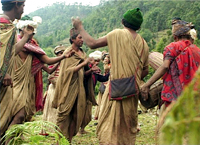|
|
They are among the last of Asia's hunter-gatherer nomads. The Rautes of west Nepal's inner tarai have long fought a hard battle to save their traditional way of life against the advances of time and technology.
The last census says there are about 2,000 Rautes, but unofficial estimates say they are far fewer. The community traditionally lives in the forests and avoids contact with outsiders. They've refused offers of permanent settlement, even from the king. As awareness of indigenous rights grows, the Rautes too are increasingly vocal about their choice to stay true to their values.
Now modern technology-digital video-might be what helps them argue their case that they just want to be left alone. When journalist-turned-filmmaker Hari Thapa, whose previous credits include the 2001 Guanthali, travelled to the inner valleys of Surkhet and Dailekh last summer, to document the Raute way of life, he had a hard time winning their trust. He managed to convince community leaders that he had no intention of settling them, and was then allowed to film for five intense days.
 The result is a 27 minute-long video that gives us the first-ever glimpse into everyday Raute life and highlights the community's perilous negotiation with the world that is slowly encroaching on the forests where they often camp. Rautes live in temporary shelters made from the branches of trees that are of lesser value to villagers. They make wooden pots from the wood of the same trees and exchange this for rice and grain in villages. Rautes only eat this grain, roots and fruit they gather in the forest, and monkeys. They burn their settlements when they leave. "Their way of life is such a brilliant indigenous survival strategy, that it sometimes seems almost too na?ve," says Thapa.
The result is a 27 minute-long video that gives us the first-ever glimpse into everyday Raute life and highlights the community's perilous negotiation with the world that is slowly encroaching on the forests where they often camp. Rautes live in temporary shelters made from the branches of trees that are of lesser value to villagers. They make wooden pots from the wood of the same trees and exchange this for rice and grain in villages. Rautes only eat this grain, roots and fruit they gather in the forest, and monkeys. They burn their settlements when they leave. "Their way of life is such a brilliant indigenous survival strategy, that it sometimes seems almost too na?ve," says Thapa.
But Raute lives are intertwined with those of people in nearby villages. As one side changes, so does the other. Traditional wood pots and leaf plates are giving way to plastic and metal utensils. There is less forested area than the community is used to, and there are more roads. It takes time to get used to traffic-and footwear, a lesson learnt the hard way when long treks along paved roads caused blisters and bleeding feet.
 The video contains rare footage, but is low on technique and image quality, in part because it was the result of a reconnaissance trip rather than a full-fledged documentary shoot set-up. Thapa will present it as a proposal, for \'conservation of endangered human species\', to the Global Environment Facility Small Grants Program to fund a two-year-long project. They aim to develop traditional Raute occupations and support Raute rights advocacy.
The video contains rare footage, but is low on technique and image quality, in part because it was the result of a reconnaissance trip rather than a full-fledged documentary shoot set-up. Thapa will present it as a proposal, for \'conservation of endangered human species\', to the Global Environment Facility Small Grants Program to fund a two-year-long project. They aim to develop traditional Raute occupations and support Raute rights advocacy.
Thapa says he is struck by how little is known about Rautes and how little sympathy there is for the community's choices. "They don't want much, not to be settled, be farmers, or be educated. They want to be allowed to live in the forests and use the few resources they use," says the soft-spoken Thapa, who hopes to start the project early next year.
Dor Bahadur Bista, one of the first non-Rautes to get close to the community, wrote in his book People of Nepal that they would not survive for long due to the rapid growth of population and settlements, deforestation, changing landscape, and rise in human traffic.
 But the community has survived and this short film shows a vibrant culture with passionate adherents.
But the community has survived and this short film shows a vibrant culture with passionate adherents.
There will be much discussion about whether the Rautes are right to keep their children away from the benefits of modernity, such as improved health care, but they at least need to be heard.
A former Raute clan head, septuagenarian Min Bahadur Shahi, speaks for his community when he declares with pride and humility, "You are the world, we are the Raute. You are kings of your palaces, we of the jungle."
And if it takes video to hold firm to their ground, well, the Raute community seems ready to adopt some modern things in the name of tradition.



